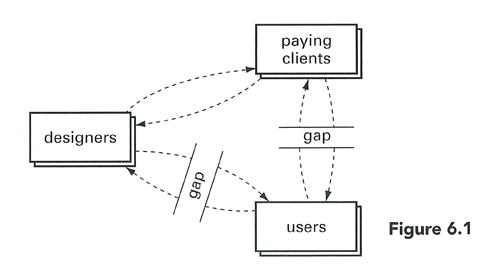The User-Needs Gap
When occasion permits, which isn’t often, I allow myself to study Bryan Lawson’s excellent book, How Designers Think. I’ve read parts before, but I’m now attempting to read it cover to cover, and about the only way I can do that is to carry it to work and back just about every day.
At lunch last week, I happened to have the book in hand. Coincidentally I flipped ahead to the chapter “A model of design problems,” which is an examination of “generators” (or groups of people) involved in the design process and the constraints they collectively and individually face.
Lawson’s description of the Users group, and particularly his analysis of the gap that exists between this group and the Designers and Clients groups, so completely and perfectly articulates a point I’ve argued repeatedly—that servicing user needs strictly through the voice a client or other mediator presents challenges in understanding and resolving true user needs.
Lawson’s background is in architectural design, but he intended the text to apply to all disciplines within design. As such, there are clearly parallels to user experience design.

Below is an extended excerpt, and above is the diagram referenced in the text:
A great deal of design today is commissioned by clients who are not themselves the users. Public architecture such as hospitals, schools or housing is usually designed by architects who have relatively little contact with the users of their buildings. Industrial design and graphic design are directed at a mass market and are usually commissioned by commercial clients. The traditional image of the designer establishing a personal relationship with a client/user is grossly misleading…. Frequently communication between designers and their users is both indirect and, as John Page has argued, filtered by organisational politics….
In local authorities, for example, both the politicians and administrators may attempt to establish themselves as the communication channel between the designers and the users outside in order to force through policy or maintain a powerful position in the system. On balance such organisational barriers, whatever advantages they give to the client body in terms of increased control over the designer, serve only to make the designer’s task of understanding the problem more difficult. Even if there are not barriers there are what Zeisel (1984) has called ‘gaps’. He referred to ‘paying clients’ and ‘user clients’. He showed that while there might often be good communications between designers and paying clients, both have a gap in their communications with user clients (Fig. 6.1)....
As many young designers must have found on leaving design schools, it is one thing to design for yourself but quite another to design for a real client with personal and institutional prejudices and biases. When that client is not even the prospective user of the design, the problem becomes even more remote. This increasing remoteness of designers from those for whom they design has created the need for user requirement studies. Almost in desperation designers have turned to social and human scientists from ergonomists through architectural psychologists to urban sociologists to tell them what their users actually need. By and large this liaison between design and social science has not been as practically useful as was first hoped. Social science remains largely descriptive while design is necessarily prescriptive, so the psychologists and sociologists have gone on researching and the designers designing, and they are yet to re-educate each other into more genuinely collaborative roles. Meanwhile the communication between the creators and users of environments often remains uncomfortably remote.
I sure hope Lawson addresses this conundrum later in the book, because I’m left wondering what can be done to eliminate this gap—aside from the obvious of just speaking directly with users, which, as Lawson stated, isn’t as easy as it seems given organizational politics. But at least for now I now have a well-articulated text I can refer to the next time this discussion pops up.








